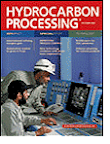Display problem ? Click HERE
Recommended :
Subscribes to FREE Hydrocarbon Processing
 A mixture is combustible / flammable if and only if the hydrocarbon composition is within mixture LFL/LEL and UFL/UEL as discussed in "Estimate Mixture Flammability & Explosivity At Reference P & T. As the operating pressure (P) and temperature (T) change (from reference P & T, the mixture LFL/LEL and UFL/UEL at P & T will change accordingly. In recent works, found in literature an interesting relationship between number of Carbon (in paraffin hydrocarbon) with LFL/LEL and UFL/UEL. This relationship is pretty useful especially when you have no information on hand.
A mixture is combustible / flammable if and only if the hydrocarbon composition is within mixture LFL/LEL and UFL/UEL as discussed in "Estimate Mixture Flammability & Explosivity At Reference P & T. As the operating pressure (P) and temperature (T) change (from reference P & T, the mixture LFL/LEL and UFL/UEL at P & T will change accordingly. In recent works, found in literature an interesting relationship between number of Carbon (in paraffin hydrocarbon) with LFL/LEL and UFL/UEL. This relationship is pretty useful especially when you have no information on hand.
A paraffin hydrocarbon with NC of Carbon (C), the Upper Explosive Limit (UFL) and Lower Explosive Limit (LFL) can be established with following equations :
Example
A Methane (CH4) contains One (1) Carbon. From literature, the UFL = 15 vol% and LFL = 5%.
From above equations,
UFL = 1 / (0.01337 x 1 + 0.05151)
UFL = 5.6% (compare to 5%)
LFL = 1 / (0.1347 x 1 + 0.04343)
LFL = 15.4% (compare to 15%)
A Propane (C3H8) contains Three (3) Carbon. From literature, the UFL = 10.1 vol% and LFL = 2.1%. From above equations,
UFL = 1 / (0.01337 x 3 + 0.05151)
UFL = 10.9% (compare to 10.1%)
LFL = 1 / (0.1347 x 3 + 0.04343)
LFL = 2.2% (compare to 2.1%)
A Hexane (C6H14) contains Six (6) Carbon. From literature, the UFL = 7.0 vol% and LFL = 1.25%. From above equations,
UFL = 1 / (0.01337 x 6 + 0.05151)
UFL = 7.6% (compare to 7%)
LFL = 1 / (0.1347 x 6 + 0.04343)
LFL = 1.2% (compare to 1.25%)
Above equation is just equations for quick estimation. It may provide some idea of UFL and LFL when no information is available. The error could be large for certain component i.e. Octane. For design and practical use, an in depth method shall be employed.
Related Topic
Subscribes to FREE Hydrocarbon Processing
A paraffin hydrocarbon with NC of Carbon (C), the Upper Explosive Limit (UFL) and Lower Explosive Limit (LFL) can be established with following equations :
Example
A Methane (CH4) contains One (1) Carbon. From literature, the UFL = 15 vol% and LFL = 5%.
From above equations,
UFL = 1 / (0.01337 x 1 + 0.05151)
UFL = 5.6% (compare to 5%)
LFL = 1 / (0.1347 x 1 + 0.04343)
LFL = 15.4% (compare to 15%)
A Propane (C3H8) contains Three (3) Carbon. From literature, the UFL = 10.1 vol% and LFL = 2.1%. From above equations,
UFL = 1 / (0.01337 x 3 + 0.05151)
UFL = 10.9% (compare to 10.1%)
LFL = 1 / (0.1347 x 3 + 0.04343)
LFL = 2.2% (compare to 2.1%)
A Hexane (C6H14) contains Six (6) Carbon. From literature, the UFL = 7.0 vol% and LFL = 1.25%. From above equations,
UFL = 1 / (0.01337 x 6 + 0.05151)
UFL = 7.6% (compare to 7%)
LFL = 1 / (0.1347 x 6 + 0.04343)
LFL = 1.2% (compare to 1.25%)
Above equation is just equations for quick estimation. It may provide some idea of UFL and LFL when no information is available. The error could be large for certain component i.e. Octane. For design and practical use, an in depth method shall be employed.
Related Topic
- Relate LFL to MOC
- Estimate Mixture Flammability & Explosivity At Operating P & T
- Estimate Mixture Flammability & Explosivity At Reference P & T
- Inert Gas or Fuel Gas For Flare Purge ?
- Nitrogen Purging - What are the factors you need to consider ?
- Fire related topics...
- Flare related topics...

No comments:
Post a Comment